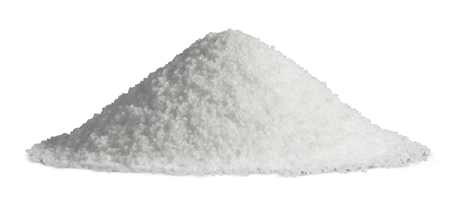SUGAR
Overview:
Sugar is a mainstay in baking, candy and confectionery production and is used as a sweetener for the food and beverage Industries. Sucrose is table sugar, granular in appearance, and is the most popular of the various sugars for flavoring, as well as for the properties (such as mouth feel, preservation, and texture) it adds to beverages and food. Powdered or confectionery sugar, as the name implies, has a powdery texture.
Sugar is a carbohydrate found in every fruit and vegetable. Once photosynthesis creates sugar, plants have the unique ability to change sugar to starch and starch to various sugars for storage. Sugar cane and sugar beet plants contain sucrose in large quantities, and that's why they are used as commercial sources of sugar. A stalk of the cane plant contains about 14% sugar. Sugar beets contain about 16% sugar.1
Extracting sugar normally involves a continuous process in one facility. The plants are washed, sliced and soaked in hot water creating a sugary juice. A series of steps — purification, filtration, concentration, and drying — completes the procedure. Raw sugar is an intermediate product in sugar production. Produced at a sugar mill, it is a tan, coarse granulated product obtained from the evaporation of clarified sugar juice. The raw sugar producer ships this product to a refinery for final processing.2
Non-food uses of sugar are in pharmaceuticals (solubility and coating), wound healing, fermentation products, organic cleaning products, glue and concrete bonding agents.
Characteristics and Challenges:
Granular sugar is free flowing, hygroscopic, agglomerates, is mildly abrasive, friable (meaning that it can be reduced to smaller pieces without much effort) and should be handled without excessive heat to avoid carmelization.
Powdered sugar is also hygroscopic, but non-free flowing, is heat sensitive and aeratable (potentially affecting handling characteristics). This means that flow promotion devices are often required when conveying sugar.
Faulty conveying of sugar in the manufacturing and/or packaging processes will not only eat away at production efficiency through unnecessary downtime, cleaning, maintenance and product loss, but it can also be dangerous.

When suspended in air, sugar dust can be extremely explosive. A 2008 explosion and fire that killed over a dozen workers at a Georgia (USA) sugar refinery, was blamed primarily on inadequately vented sugar dust.3 The US Occupational Safety & Health Administration has placed sugar handling in the high risk category4 and the US National Fire Protection Association has adopted new regulations concerning explosion protection of sugar handling equipment.
If the sugar is being pneumatically conveyed into a processing system, the blower used to move the air line must be sized to meet the demands of system. Due to the hygroscopic nature of sugar, it absorbs moisture from the air. If this problem causes excessive clumping, additional devices may be required to reduce the humidity levels or draw moisture from the sugar prior to its entrance into the conveyor. In the same method, air cooling or heating devices could be employed to moderate the temperature of the sugar during the conveying process.
If the sugar arrives at the processing facility in large bulk bags, the frames used to discharge the bags usually require additional accessories to completely empty the bags and prevent any fine sugar dust particles from escaping into the surrounding atmosphere. If the sugar is packaged in smaller (>50 lb) bags, a bag-emptying station with a dust hood, filtration devices and a pneumatic pulse cleaner may be sufficient to support the manual unloading of the material.
Some powdered sugars will tend to agglomerate, "rat hole" or bridge in hoppers, interrupting the flow of the material. Feed hoppers should be designed with proper geometry and may need to incorporate devices such as air fluidizers, vibrators or mechanical agitators to promote flow. A hopper screen above the receiving vessel will help protect the operators if the sugar is being dumped manually into a hopper that is equipped with agitating devices.
If a flexible screw is being used to convey the sugar, it is important to use a screw that matches the sugar's characteristics and other application requirements. Generally a screw with a wider, flatter surface is necessary for moving sugar up an incline.
Flexicon Applications:
Consultation with a Flexicon specialist will help you decide if a flexible screw or pneumatic solution best fits your sugar application. Flexicon's expert design and engineering staff will weigh each parameter and recommend the best solution for you. Upon request, Flexicon's test lab will simulate your sugar handling applications before the system is installed in your plant.
A Flexicon bulk handling system automated the unloading of several powders (including sugar) and speeded the blending process by 25% for an Ohio, USA chocolate manufacturer. Sugar is also one of the materials handled in a blending process for an American organic food manufacturer. Our flexible screw conveyor moves all of their disparate particle sizes and bulk density ingredients, including sugar, without causing the blend to separate.
Flexicon's Dust Suppression and Collection Systems ensure proper containment of sugar throughout the conveyance process. Flexicon's High-Flow Hopper, purpose-built for flexible screw conveyors, increases the flow of both free- and non-free-flowing bulk materials while eliminating or decreasing the amount of residual material in the hopper as well as the need for flow promotion devices, and is perfectly suited for sugar handling.
Flexicon's product line of advanced flow promotion conveyors, high flow hoppers, deaeration/densification decks and a host of other components and accessories are proven performers that promote flow while reducing degradation, dusting and/or the separation of blends comprised of disparate particles.
Related Articles on Sugar:
1 The Sugar Association
2 Ibid
3 Industrial Plant Safety: Imperial Sugar Dust Explosion Final Report
4 Occupational Safety & Health Administration: Combustible Dust Report
Sources: Where noted. All other information courtesy of Flexicon Corporation.